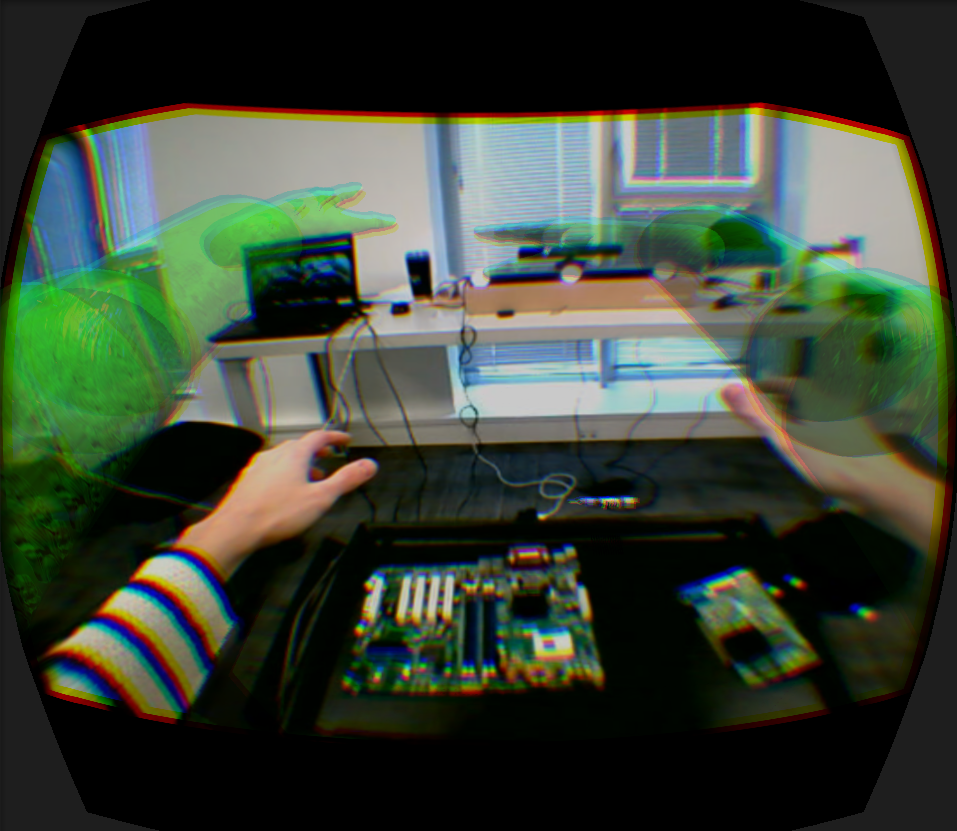Section: New Results
Collaborative Virtual Environments
Asymetric Remote Collaboration in Mixed Reality: Awareness and Navigation Morgan Le Chénéchal, Valérie Gouranton and Bruno Arnaldi
We first focused on the lack of mutual awareness that may appear in many situations and we evaluated different ways to present the distant user and his actions in the Virtual Environment (VE) in order to understand his perception and cognitive process. We focused on a common case consisting in estimating accurately the time at which a distant user analyzed the meaning of a remotely pointed object. Amongst others, our experimental results presented at CTS [28] , show that expertise of the users influences on how they estimate the distant activity and the type of applied strategies.
Then, in a similar asymmetric setup, we proposed a demo at IEEE VR to deal with real estate business. In this context, it is quite difficult for estate agents to make customers understand the potential and the volumes of free spaces. The demo aimed to solve these issues based on a laying out scenario in which a seller and a customer collaborate. As the roles of both users are different, we proposed an asymmetric collaboration where the two users do not use the same interaction setup and do not benefit from the same interaction capabilities.
Last, we focused on a remote collaborative maintenance scenario in which a remote expert helps an operator in performing a physical task 9 . Our system is based on a VR setup for the remote expert in order to virtually co-locates him in the real workspace, and an AR interface for the display of the helping gestures to the agent. In a preliminary user study, we evaluated the performance of our system in a navigation task, and we presented results at ICAT-EGVE [29] .
This work was done in collaboration with Thierry Duval (Lab-STICC) and Jérome Royan (IRT B-Com).
High-Level Components for Developing Collaborative and Interactive Virtual Environments Rozenn Bouville, Valérie Gouranton, Thomas Boggini, Florian Nouviale and Bruno Arnaldi
We proposed a framework called #FIVE (Framework for Interactive Virtual Environments) for the development of interactive and collaborative virtual environments [22] . It has been developed for an easier and a faster design and development of virtual reality applications. It was designed with a constant focus on re-usability with as few hypotheses as possible on the final application in which it could be used. Whatever the chosen implementation for the Virtual Environment (VE), #FIVE : (1) provides a toolkit that eases the declaration of possible actions and behaviours of objects in the VE, (2) provides a toolkit that facilitates the setting and the management of collaborative interactions in a VE, (3) is compliant with distribution of the VE on different setups and (4) proposes guidelines to efficiently create a collabo-rative and interactive VE. It is composed of several modules, among them, two core modules : the relation engine and the collaborative interaction engine. On the one hand, the relation engine manages the relations between the objects of the environment. On the other hand, the collaborative interaction engine manages how users can collaboratively control objects. The modules that compose the #FIVE framework can be used either independently or simultaneously , depending on the requirements of the application. They can also communicate and work with other modules thanks to an API. For instance, a scenario engine can be plugged to any or both of the #FIVE modules if the application is scenario-based. #FIVE has already been used in VR applications by several members of our team (see section 6.5 ). The feedbacks are rather positive and we intend to further develop #FIVE with additional functionalities, notably by extending it to the control of avatars whether they are controlled by a user or by the system.
High-Level Components for Developing Collaborative Scenarios Guillaume Claude, Valérie Gouranton and Bruno Arnaldi
We were interested in the description of activities of actors in Collaborative Virtual Environments for Training to team working on procedures. We have proposed #SEVEN, a model for the description of procedures as Collaborative Virtuel Environments Scenarios (see also section 6.6 ). In [25] we have demonstrated the abilities of this model to be adapted to a wide range of use cases. We showed that it can adapt its abstraction level to the required guidance level and describe more or less complex unfolding of events. In [24] we have provided a novel approach to the distribution of the actions between the actors of the simulation by using an action filtering model in conjunction with a reactive team model. The action filtering model uses data about the actors such as their abilities or their rights. Our reactive team model can be used to define relationships between the team members and the effects of inner rules of the team upon the involvement of the actors in the procedure. To our knowledge, our solution is the closest to the existing models proposed by the social science domain known as role theory. Our work has been applied to several domains, including the training of scrub nurses to neurosurgery procedures 10 .



